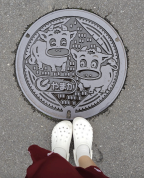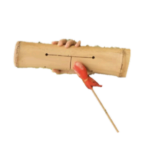This site is available in multiple languages. Please select your preferred language from the bar at the bottom right.
Craft Kyushu | A report from an international student living in Kyushu about the real experiences and excitement of traditional crafts

しんじゅ
In Kyushu, there is a place called Nakayamaga,

In Kyushu, there is a place called Nakayamaga, where there are mountains, songs, paintings, and an everlasting youth that never fades. When we arrived there, we prepared to make a musical instrument made from bamboo. I wanted to name it "Takegaku" (Bamboo Music). First, we cut the bamboo to a suitable length, then carved two lines lengthwise in the middle, and connected these lines horizontally. Thus, a simple bamboo instrument was completed.
Of course, the tools for striking the bamboo instrument are also easy to make. We shaved bamboo into long, thin chopstick-like shapes and adjusted the length to our convenience. When lightly tapped on the bamboo instrument, a crisp sound sprang forth. Interestingly, when we struck three or four bamboo instruments together, each produced a different tone, creating a wonderful natural orchestra.
The following photos show various musical instruments made by local people using bamboo.

After finishing making the bamboo instruments, it was already lunchtime. We went to a local community cafeteria and had a curry meal for just 200 yen. It was the cheapest and most delicious meal I had in Japan, fragrant and unforgettable.

After lunch, we gathered at a community activity center, where local people's artworks were displayed. Using the instruments we made ourselves, we held an impromptu small concert. At first, the sounds were somewhat chaotic, but gradually, we seemed to reach a kind of harmony, and the music became more harmonious. That day, the sky was heavily overcast and the wind was strong, as if even the clouds and wind were dancing to our melody. It was originally a cloudy day, but at the moment we played, sunlight suddenly shone through, as if it had joined our concert, warming the chill of autumn and the hearts of every performer.
After the performance, we admired the surrounding paintings. What impressed me the most was a painter who drew inspiration from the sounds of Japanese characters to create a variety of unique styles.
Afterward, we strolled along rural paths surrounded almost entirely by farmland and mountains. Yet, the creativity of the locals was everywhere. Along the way, we saw many simple yet stylish decorations and instruments made from bamboo.


When small stones are dropped into a bamboo tube, you can clearly hear the sound of dripping water. Different sizes of bamboo produce different sounds. It feels as if we have slowed down the fast pace of life and are listening to the sounds of nature.Do you think the wind has a sound? If so, what kind of sound is it? I feel that standing here...
The answer can be found on the bamboo. There are small holes on the bamboo, and when the strong wind blows, if you put your ear close to the holes, you can hear the sound of the wind.

In the evening, we passed by a fried chicken shop. Although it was already closed, the enthusiastic owner freshly fried some chicken for us. The fried chicken was crispy on the outside and tender on the inside, with an irresistible aroma. What was special was that the chicken was skewered on sticks—this was the first time I had seen fried chicken skewers like this in Japan.


As we were about to leave, a local dance event was taking place. People formed a circle and danced gracefully, seemingly performing a traditional Japanese cultural dance. Although we were pressed for time to catch the train, the enthusiastic locals invited us to join, and I couldn’t help but dance along, fully immersed in the joy. That day was truly unforgettable and filled with happiness.
Report
Report language :
Chinese (Simplified)






